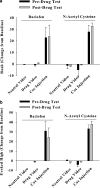Repeated N-acetyl cysteine reduces cocaine seeking in rodents and craving in cocaine-dependent humans
- PMID: 21160464
- PMCID: PMC3052624
- DOI: 10.1038/npp.2010.226
Repeated N-acetyl cysteine reduces cocaine seeking in rodents and craving in cocaine-dependent humans
Abstract
Addiction is a chronic relapsing disorder hypothesized to be produced by drug-induced plasticity that renders individuals vulnerable to craving-inducing stimuli such as re-exposure to the drug of abuse. Drug-induced plasticity that may result in the addiction phenotype includes increased excitatory signaling within corticostriatal pathways that correlates with craving in humans and is necessary for reinstatement in rodents. Reduced cystine-glutamate exchange by system x(c)- appears to contribute to heightened excitatory signaling within the striatum, thereby posing this as a novel target in the treatment of addiction. In the present report, we examined the impact of repeated N-acetyl cysteine, which is commonly used to activate cystine-glutamate exchange, on reinstatement in rodents in a preclinical study and on craving in cocaine-dependent humans in a preliminary, proof-of-concept clinical experiment. Interestingly, repeated administration (7 days) of N-acetyl cysteine (60 mg/kg, IP) produced a significant reduction in cocaine (10 mg/kg, IP)-induced reinstatement, even though rats (N=10-12/group) were tested 24 h after the last administration of N-acetyl cysteine. The reduction in behavior despite the absence of the N-acetyl cysteine indicates that repeated N-acetyl cysteine may have altered drug-induced plasticity that underlies drug-seeking behavior. In parallel, our preliminary clinical data indicate that repeated administration (4 days) of N-acetyl cysteine (1200-2400 mg/day) to cocaine-dependent human subjects (N=4 per group) produced a significant reduction in craving following an experimenter-delivered IV injection of cocaine (20 mg/70 kg/60 s). Collectively, these data demonstrate that N-acetyl cysteine diminishes the motivational qualities of a cocaine challenge injection possibly by altering pathogenic drug-induced plasticity.
Figures





References
-
- Abreu ME, Bigelow GE, Fleisher L, Walsh SL. Effect of intravenous injection speed on responses to cocaine and hydromorphone in humans. Psychopharmacology (Berl) 2001;154:76–84. - PubMed
-
- Baker DA, McFarland K, Lake RW, Shen H, Tang XC, Toda S, et al. Neuroadaptations in cystine-glutamate exchange underlie cocaine relapse. Nat Neurosci. 2003;6:743–749. - PubMed
-
- Breiter HC, Gollub RL, Weisskoff RM, Kennedy DN, Makris N, Berke JD, et al. Acute effects of cocaine on human brain activity and emotion. Neuron. 1997;19:591–611. - PubMed
Publication types
MeSH terms
Substances
Grants and funding
- DA010214/DA/NIDA NIH HHS/United States
- R01 DA015758/DA/NIDA NIH HHS/United States
- DA09465/DA/NIDA NIH HHS/United States
- R01 DA017328/DA/NIDA NIH HHS/United States
- M01 RR000058/RR/NCRR NIH HHS/United States
- DA025617/DA/NIDA NIH HHS/United States
- Z01 DA000486/ImNIH/Intramural NIH HHS/United States
- R01 DA025617/DA/NIDA NIH HHS/United States
- R01 DA009465/DA/NIDA NIH HHS/United States
- F30 DA019754/DA/NIDA NIH HHS/United States
- K23 DA000486/DA/NIDA NIH HHS/United States
- RR00058/RR/NCRR NIH HHS/United States
- DA017328/DA/NIDA NIH HHS/United States
- DA015758/DA/NIDA NIH HHS/United States
- R01 DA010214/DA/NIDA NIH HHS/United States
- DA019754/DA/NIDA NIH HHS/United States
LinkOut - more resources
Full Text Sources
Medical

